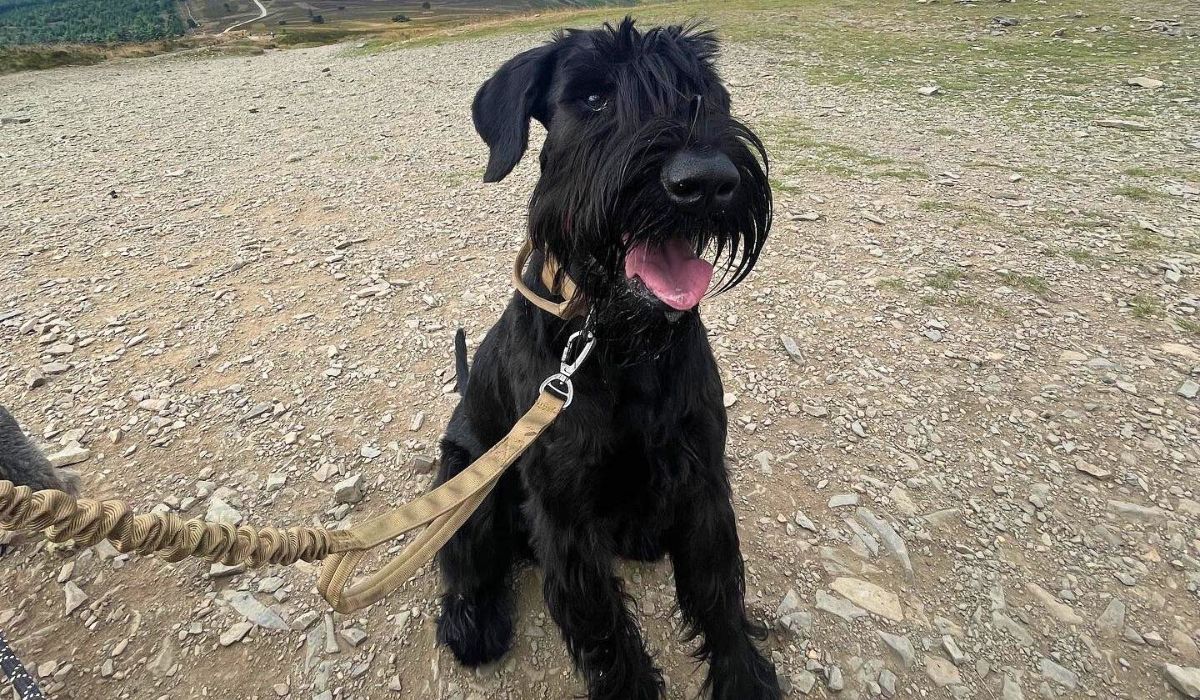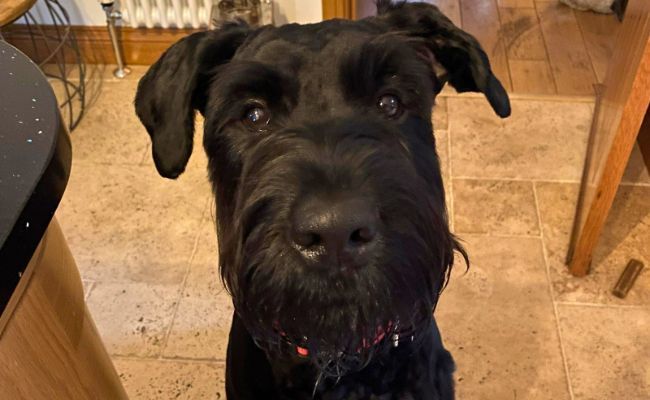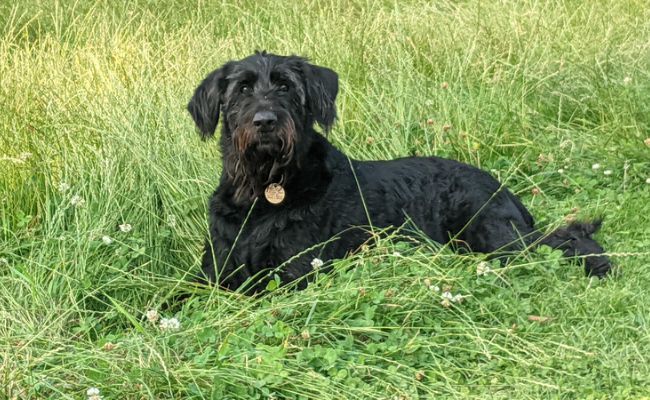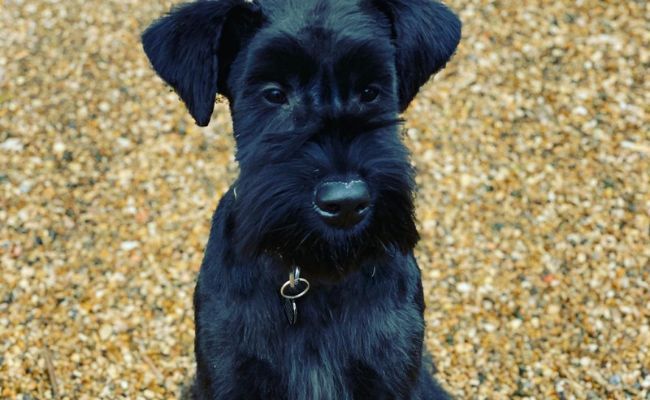
Giant Schnauzer
10 July 2023
Let’s talk about… Giant Schnauzers: what are they?
- Giant Schnauzers are an impressive and versatile breed that originated in Germany.
- They were developed to be all-around working dogs, excelling in tasks such as herding, guarding, and driving livestock.
- As well as working on farms, due to the Giant Schnauzer’s guarding abilities they started to be owned by tavern owners and butchers as well to protect their establishments.
- Today, they are also beloved family companions and can participate in various dog sports and activities.
- Giant Schnauzers have a powerful and robust build, with males typically standing between 65-70 cm in height, and females slightly shorter at 60-65 cm.
- They weigh between 35-47 kg on average.
- The average life expectancy of Giant Schnauzers is around 10 to 12 years.

What is the temperament of Giant Schnauzers like?
- Giant Schnauzers are intelligent, loyal, and protective dogs.
- They are known for their strong and dominant personalities, making them more suitable for experienced dog owners.
- They form deep bonds with their families and can be fiercely protective, making them excellent guard dogs.
- While they are generally good with children and can be loving family pets, they may have a tendency to be dominant or assertive with other dogs, especially those of the same sex.
- Early socialisation and proper training are crucial to ensure they develop good manners and learn to interact positively with other animals and unfamiliar people.
- Giant Schnauzers thrive on mental and physical stimulation. They require regular exercise, training, and activities to keep them engaged and prevent boredom.
- Adequate socialisation, obedience training, and structured activities can help channel their energy in a positive direction.

How much exercise do Giant Schnauzers need?
- Giant Schnauzers are a high-energy breed and require a substantial amount of exercise to keep them physically and mentally stimulated. They benefit from at least 2 hours of exercise per day.
- This should include activities such as brisk walks, jogging, interactive play sessions, and mentally challenging tasks like obedience training, agility, or tracking.
- It's important to note that Giant Schnauzer puppies have developing bones and joints, and their exercise should be carefully managed to avoid excessive strain.
- Young puppies should have short and controlled play sessions and gentle walks.
- As a very general guideline, puppies can start with around 5 minutes of exercise per month of age, up to twice a day.
- By the time they reach around 12 to 18 months of age, they can gradually increase their exercise duration and intensity. Consult with your vet for personalised advice based on your puppy's growth and development.
- Giant Schnauzers typically reach their full exercise capacity at an adult level around 18 to 24 months of age. Individual dogs may vary, so it's important to monitor their energy levels and adjust their exercise accordingly.

Do Giant Schnauzers need a lot of grooming?
- Giant Schnauzers have a wiry double coat that requires regular grooming to keep it in good condition.
- Their coat consists of a soft undercoat and a harsh, dense outer coat.
- They require brushing at least once or twice a week to prevent matting and remove loose hair.
- Additionally, they need to be hand-stripped or professionally groomed every 6 to 8 weeks to maintain their coat texture.
- Giant Schnauzers have facial hair that requires regular trimming to keep their vision clear and prevent food from getting caught in their beard.
- Like any dog, regular tooth brushing with a dog-specific toothpaste twice daily is ideal. If you can’t manage that often, just do it as often as you can.

Are Giant Schnauzers Easy to Train?
- Giant Schnauzers are intelligent and versatile dogs that can excel in training when provided with the right guidance and approach.
- While they possess a strong will and independent nature, with consistent training, positive reinforcement, and clear expectations, Giant Schnauzers can be trained effectively by an experienced dog owner.
- Starting early with socialisation and basic obedience, and incorporating mental stimulation and physical exercise into their routine are key factors in successfully training Giant Schnauzers.
- Their intelligence and eagerness to please can work in your favour, making them trainable with patience and positive reinforcement techniques.

What do Giant Schnauzers eat?
- Giant Schnauzers should be fed a balanced and nutritious diet to support their overall health. High-quality large breed commercial dog food that is appropriate for their age, size, and activity level is recommended. The amount of food will depend on factors such as metabolism, weight, and exercise routine.
- For Giant Schnauzer puppies, it's important to feed them a specifically formulated large breed puppy food to support their growth and development. Puppies have different nutritional needs than adult dogs and require a higher calorie intake. Follow the feeding guidelines provided by the food manufacturer and consult with a veterinarian for personalised recommendations based on your puppy's age and specific requirements.
- Puppies should be fed 3-4 times a day until they are six month old when you can reduce to twice a day
- As Giant Schnauzers mature into adults, they can transition to adult large breed dog food at about 18-24 months. Choose a reputable brand that offers complete and balanced nutrition. Monitor their weight and body condition and adjust their portions accordingly to maintain a healthy weight and as per advice from your vet.
- It's important to avoid overfeeding or excessive treats, as Giant Schnauzers can be prone to weight gain.
Are Giant Schnauzers healthy?
Giant Schnauzers are generally a healthy breed, but they may be susceptible to certain health conditions. Some common health concerns in Giant Schnauzers include:
Bones and Joints
- Hip Dysplasia - a condition where the thigh bone and pelvis do not sit together properly at the hip joint, which can lead to discomfort and arthritis
- Panosteitis - a painful, inflammatory condition of the long bones of the leg
Gastrointestinal
- Gastric Dilation Volvulus (GDV) - this occurs when the stomach twists and gas and contents get trapped inside. It is a very serious condition and a vet should be contacted immediately!
Heart
- Dilated Cardiomyopathy (DCM) - a disease of the heart muscle causing the heart ventricles to get larger
Hormonal
- Hypothyroidism - a condition where your dog does not produce enough thyroid hormone
Urinary
- Bladder Stones - Stones form in the bladder which can be uncomfortable and cause a blockage
This list is by no means comprehensive, if you have any concerns about the health of your dog, or if you want to discuss further if a Giant Schnauzer is right for you, consult with your vet.
BorrowMyDoggy loves Giant Schnauzers
BorrowMyDoggy has 186 Giant Schnauzer members.
Information on this page should never replace advice given by your veterinarian. Potential health issues presented are given as a guide only and are not meant to be comprehensive. If you ever have any concerns about your dog’s health contact your local vet.
Large Working Type Dog Breed Guides
Know someone who'd love this?
Hey there!
Want to hear about a different kind of dog care that both you and your dog will love?
Or perhaps you're a dog lover who can't have one of your own right now?
We have the pawfect solution, BorrowMyDoggy!
How it works
Old Tyme Bulldog
Learn facts about the Old Tyme Bulldog dog breed from the BorrowMyDoggy community in our Old Tyme Bulldog guide!
Read article
Norwegian Elkhound
Learn facts about the Norwegian Elkhound dog breed from the BorrowMyDoggy community in our Norwegian Elkhound Terrier guide!
Read article
Dandie Dinmont Terrier
Learn facts about the Dandie Dinmonth Terrier dog breed from the BorrowMyDoggy community in our Dandie Dinmonth Terrier guide!
Read article
American Bulldog
Learn facts about the American Bulldog dog breed from the BorrowMyDoggy community in our American Bulldog guide!
Read article